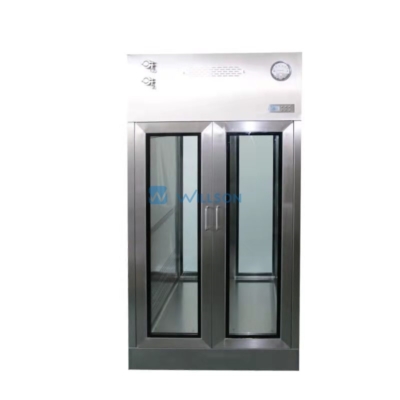In cleanroom environments, pass boxes are essential tools for maintaining the cleanliness and integrity of the space. They allow for the transfer of materials and equipment between different areas of the cleanroom without compromising the controlled environment. There are two main types of pass boxes: dynamic pass boxes and static pass boxes. In this post, we’ll explore the differences between these two types of pass boxes, as well as the various types of dynamic pass boxes and their applications.

- Dynamic Pass Box vs. Static Pass Box
The main difference between dynamic pass boxes and static pass boxes lies in their airflow. Dynamic pass boxes are designed to maintain positive pressure inside the box, which prevents contaminants from entering the cleanroom. As a result, they are ideal for transferring materials and equipment from a less clean area to a cleaner area. Static pass boxes, on the other hand, do not have any airflow control and are typically used for transferring materials and equipment between two areas of equal cleanliness.
- Features and functions of Dynamic Pass Box
- Airflow Control
Dynamic pass box is equipped with a HEPA filter that ensures the air entering and exiting the box is free of contaminants. The airflow is controlled by a blower that creates positive pressure inside the box, preventing the entry of contaminants from the outside environment.
- Air Showering
Dynamic pass boxes are equipped with advanced air showering systems that use HEPA filters to remove 99.99% of particles as small as 0.3 microns in size. These filters are designed to capture even the smallest particles, including bacteria and viruses, ensuring that the air entering the cleanroom is free from contaminants. The air showering process is initiated automatically when the pass box door is closed, and it continues for a predetermined period of time to ensure that all contaminants are removed.
- Interlocking Doors
Dynamic pass box has interlocking doors that prevent both doors from being opened at the same time. This feature ensures that only one door is open at any given time, preventing cross-contamination between the two areas.
- UV Germicidal Lamp
Dynamic pass box is equipped with a UV germicidal lamp that kills bacteria and viruses present in the air and on surfaces. This feature ensures that the box is free of any microbial contamination.
- Smooth Surface
Dynamic pass box has a smooth surface that is easy to clean and maintain. The surface is made of stainless steel, which is resistant to corrosion and can withstand harsh cleaning agents. The two interlocking doors are recessed design, flush with the whole box case
- Audiovisual Alarm
Dynamic pass box has an audiovisual alarm that alerts users when the doors are open for an extended period. This feature ensures that the box is not left open for too long, preventing contamination of the clean area.
- Customization
Dynamic pass box can be customized to suit specific requirements. The size of the box can be adjusted to fit the available space and accommodate various equipment or materials, it can be wall-mounted and floor-type as per different size.
- Applications of Dynamic Pass Boxes
Dynamic pass boxes are used in a variety of industries, including pharmaceuticals, biotechnology, electronics, and food processing. They are particularly useful in cleanroom environments where maintaining a controlled environment is essential for product quality and safety. Some common applications of dynamic pass boxes include:
- Transferring materials and equipment between different areas of a cleanroom.
- Sterilizing or decontaminating materials and equipment before they enter the cleanroom.
- Preventing cross-contamination between different areas of a cleanroom.
Dynamic pass boxes are an important tool for maintaining the cleanliness and integrity of cleanroom environments. They offer several advantages over static pass boxes, including airflow control and the ability to transfer materials and equipment between areas of different cleanliness levels. By understanding the functions and features of dynamic pass boxes and their applications, you can select the right pass box for your specific needs and ensure that your cleanroom remains contamination-free.


